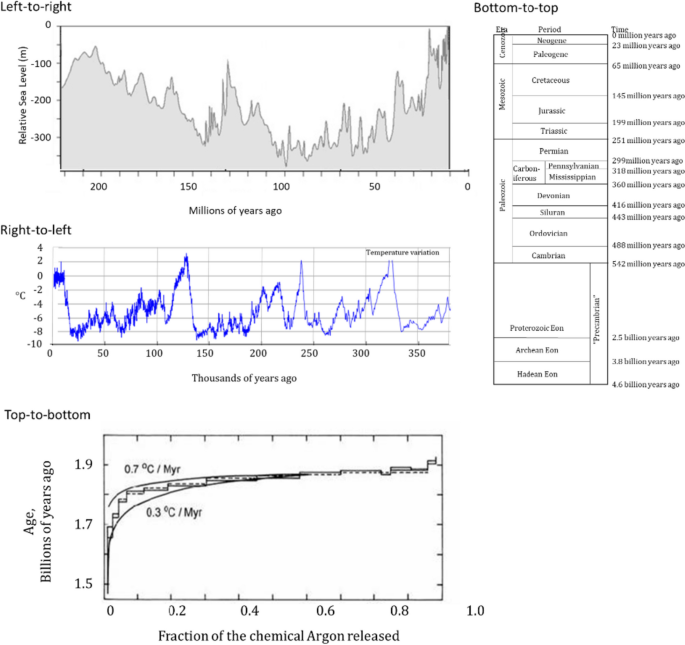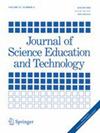Which Way Does Time Go? Differences in Expert and Novice Representations of Temporal Information at Extreme Scales Interferes with Novice Understanding of Graphs
IF 5.5
1区 教育学
Q1 EDUCATION & EDUCATIONAL RESEARCH
引用次数: 0
Abstract
Abstract Visual representations of data are widely used for communication and understanding, particularly in science, technology, engineering, and mathematics (STEM). However, despite their importance, many people have difficulty understanding data-based visualizations. This work presents a series of three studies that examine how understanding time-based Earth-science data visualizations are influenced by scale and the different directions time can be represented (e.g., the Geologic Time Scale represents time moving from bottom-to-top, whereas many calendars represent time moving left-to-right). In Study 1, 316 visualizations from two top scholarly geoscience journals were analyzed for how time was represented. These expert-made graphs represented time in a range of ways, with smaller timescales more likely to be represented as moving left-to-right and larger scales more likely to be represented in other directions. In Study 2, 47 STEM novices were recruited from an undergraduate psychology experiment pool and asked to construct four separate graphs representing change over two scales of time (Earth’s history or a single day) and two phenomena (temperature or sea level). Novices overwhelmingly represented time moving from left-to-right, regardless of scale. In Study 3, 40 STEM novices were shown expert-made graphs where the direction of time varied. Novices had difficulty interpreting the expert-made graphs when time was represented moving in directions other than left-to-right. The study highlights the importance of considering representations of time and scale in STEM education and offers insights into how experts and novices approach visualizations. The findings inform the development of educational resources and strategies to improve students’ understanding of scientific concepts where time and space are intrinsically related.

时间走哪条路?专家和新手在极端尺度下时间信息表示的差异会干扰新手对图的理解
数据的可视化表示被广泛用于交流和理解,特别是在科学、技术、工程和数学(STEM)领域。然而,尽管它们很重要,但许多人很难理解基于数据的可视化。这项工作提出了一系列三项研究,研究了理解基于时间的地球科学数据可视化如何受到尺度和时间可以表示的不同方向的影响(例如,地质时间尺度表示从下到上的时间,而许多日历表示从左到右的时间)。在研究1中,我们分析了来自两个顶级学术地球科学期刊的316个可视化图像,以了解时间是如何表示的。这些专家制作的图表以各种方式表示时间,较小的时间尺度更可能表示为从左向右移动,而较大的时间尺度更可能表示为其他方向。在研究2中,从本科心理学实验池中招募了47名STEM新手,并要求他们构建四个独立的图表,代表两个时间尺度(地球历史或一天)和两个现象(温度或海平面)的变化。绝大多数新手表示时间从左到右移动,无论规模如何。在研究3中,向40名STEM新手展示了专家制作的时间方向变化的图表。当时间以从左到右以外的方向移动时,新手很难理解专家制作的图表。该研究强调了在STEM教育中考虑时间和规模表示的重要性,并为专家和新手如何处理可视化提供了见解。研究结果为开发教育资源和策略提供了信息,以提高学生对时间和空间内在相关的科学概念的理解。
本文章由计算机程序翻译,如有差异,请以英文原文为准。
求助全文
约1分钟内获得全文
求助全文
来源期刊

Journal of Science Education and Technology
EDUCATION, SCIENTIFIC DISCIPLINES-
CiteScore
9.40
自引率
4.50%
发文量
45
审稿时长
6-12 weeks
期刊介绍:
Journal of Science Education and Technology is an interdisciplinary forum for the publication of original peer-reviewed, contributed and invited research articles of the highest quality that address the intersection of science education and technology with implications for improving and enhancing science education at all levels across the world. Topics covered can be categorized as disciplinary (biology, chemistry, physics, as well as some applications of computer science and engineering, including the processes of learning, teaching and teacher development), technological (hardware, software, deigned and situated environments involving applications characterized as with, through and in), and organizational (legislation, administration, implementation and teacher enhancement). Insofar as technology plays an ever-increasing role in our understanding and development of science disciplines, in the social relationships among people, information and institutions, the journal includes it as a component of science education. The journal provides a stimulating and informative variety of research papers that expand and deepen our theoretical understanding while providing practice and policy based implications in the anticipation that such high-quality work shared among a broad coalition of individuals and groups will facilitate future efforts.
 求助内容:
求助内容: 应助结果提醒方式:
应助结果提醒方式:


